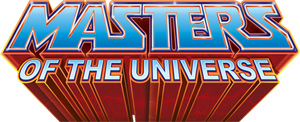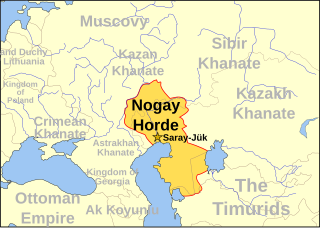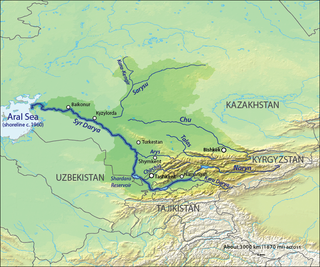Horde may refer to:
Horde may refer to:

Kazakhstan, the largest country fully within the Eurasian Steppe, has been a historical crossroads and home to numerous different peoples, states and empires throughout history. Throughout history, peoples on the territory of modern Kazakhstan had nomadic lifestyle, which developed and influenced Kazakh culture.
Icarus is a character in Greek mythology.

The Golden Horde, self-designated as Ulug Ulus, was originally a Mongol and later Turkicized khanate established in the 13th century and originating as the northwestern sector of the Mongol Empire. With the division of the Mongol Empire after 1259, it became a functionally separate khanate. It is also known as the Kipchak Khanate or the Ulus of Jochi, and replaced the earlier, less organized Cuman–Kipchak confederation.

Adora, known by her alter ego She-Ra, is a fictional superheroine in the Masters of the Universe franchise. She is introduced as the protagonist of the 1985 Filmation series She-Ra: Princess of Power, which reveals her to be the long lost twin sister of He-Man. She-Ra again appears in the 2018 reboot She-Ra and the Princesses of Power. A series of toys under her name was produced by Mattel in 1984. She has also appeared in a number of Masters of the Universe comic books, most notably in DC Comics' 2012–2018 MOTU comic series, a roughly 1,000 page single story arc, collected in the 2019 He-Man and the Masters of the Universe Omnibus hardcover release. In these comics and in the Masters of the Universe Classics toyline, she also has an evil persona called Despara. As Despara, she makes an appearance at the end of Rob David and Kevin Smith's 2024 Netflix release Masters of the Universe: Revolution, the third installment of the 2021 Masters of the Universe: Revelation animated series. She also features in multiple story books, mainly Golden Books and Ladybird books, and in some MOTU games.

A kurultai was a political and military council of ancient Mongol and Turkic chiefs and khans. The root of the term is from the Proto-Mongolic verb *kura-, *kurija- 'to collect, to gather' whence khural 'meeting, assembly' in Mongolic languages. From this same root arises the Mongolian word хурим khurim 'feast', which originally referred to large festive gatherings on the steppe, but it is now used mainly in the sense of 'wedding'.
Venom is a class of animal toxins.

Masters of the Universe is a sword and planet-themed media franchise created by Mattel. The main premise revolves around the conflict between He-Man and Skeletor on the planet Eternia, with a vast lineup of supporting characters in a hybrid setting of medieval sword and sorcery, and sci-fi technology. A follow-up series, She-Ra: Princess of Power revolves around He-Man's sister She-Ra and her rebellion against The Horde on the planet Etheria. Since its initial launch, the franchise has spawned a variety of products, including multiple lines of action figures, six animated television series, several comic series, video games, books and magazines, a daily newspaper comic strip, and two feature films.
Tarkhan is an ancient Central Asian title used by various Turkic, Hungarian, Mongolic, and Iranian peoples. Its use was common among the successors of the Mongol Empire and Turkic Khaganate.
A scorpion is a predatory arthropod animal.
An elemental is a type of magical entity who personifies a force of nature and controls natural powers derived from their element.

The Nogai Horde was a confederation founded by the Nogais that occupied the Pontic–Caspian steppe from about 1500 until they were pushed west by the Kalmyks and south by the Russians in the 17th century. The Mongol tribe called the Manghuds constituted a core of the Nogai Horde.

Orda Ichen was a Mongol Khan and military strategist who ruled the eastern part of the Golden Horde during the 13th century.
A khanate or khaganate is a type of historic polity ruled by a khan, khagan, khatun, or khanum. Khanates were typically nomadic Turkic, Mongol and Tatar societies located on the Eurasian Steppe, politically equivalent in status to kinship-based chiefdoms and feudal monarchies. Khanates and khaganates were organised tribally, where leaders gained power on the support and loyalty of their warrior subjects, gaining tribute from subordinates as realm funding. In comparison to a khanate, a khaganate, the realm of a khagan, was a large nomadic state maintaining subjugation over numerous smaller khanates. The title of khagan, translating as "Khan of the Khans", roughly corresponds in status to that of an emperor.

The Eurasian Steppe, also called the Great Steppe or The Steppes, is the vast steppe ecoregion of Eurasia in the temperate grasslands, savannas and shrublands biome. It stretches through Hungary, Bulgaria, Romania, Moldova, Ukraine, southern Russia, Kazakhstan, Xinjiang, Mongolia and Manchuria, with one major exclave, the Pannonian steppe, located mostly in Hungary.

Nomadic empires, sometimes also called steppe empires, Central or Inner Asian empires, were the empires erected by the bow-wielding, horse-riding, nomadic people in the Eurasian Steppe, from classical antiquity (Scythia) to the early modern era (Dzungars). They are the most prominent example of non-sedentary polities.
The Wings of the Golden Horde were subdivisions of the Golden Horde in the 13th to 15th centuries CE. Jochi, the eldest son of the Mongol Empire founder Genghis Khan, had several sons who inherited Jochi's dominions as fiefs under the rule of two of the brothers, Batu Khan and the elder Orda Khan who agreed that Batu enjoyed primacy as the supreme khan of the Golden Horde.
Golden Horde was a Mongol khanate established in the 13th century, and reaching from northern Central-Asia to the Black Sea.
An orda or horde was a historical sociopolitical and military structure found on the Eurasian Steppe, usually associated with the Turkic and Mongol peoples. This form of entity can be seen as the regional equivalent of a clan or a tribe. Some successful ordas gave rise to khanates.

This article summarizes the History of the western steppe, which is the western third of the Eurasian steppe, that is, the grasslands of Ukraine and southern Russia. It is intended as a summary and an index to the more-detailed linked articles. It is a companion to History of the central steppe and History of the eastern steppe. All dates are approximate since there are few exact starting and ending dates. This summary article does not list the uncertainties, which are many. For these, see the linked articles.

This is a short History of the central steppe, an area roughly equivalent to modern Kazakhstan. Because the history is complex it is mainly an outline and index to the more detailed articles given in the links. It is a companion to History of the western steppe and History of the eastern steppe and is parallel to the History of Kazakhstan and the History of Central Asia.